Home> Scales
> Soloing
Over Chords 2
With step 1 out the way - finding the key/root note - we can now
move on to identifying the chord type we'll be soloing over. This will,
in part, determine which scales/tones we can use in our solo.
The most basic chord types are known as triads - 3 note chords. These triad types are major, minor, suspended, diminished and augmented.
All chords are based on one of these triads, but some may contain additional notes, giving us extended chords.
First, let's focus on triads, as these are the basis of all chord types and will help us narrow down which scales and notes we can use in our solo. There's some overlap between this lesson and the first two parts of the guitar chord theory series, so it's beneficial to spend some time on that series getting to know how chords are constructed.
Video Lesson
This means we can use any major scale over that chord, as all major scales contain this triad and you'll see these tones appear in the major scale diagrams on this site. Any additional tones in the scale can be seen as "colouring" the basic major sound. Each scale has its own unique major flavour.
Let's say our backing chord is D major. This means the root note will be D. In the first part, I recommended that you use the bottom 2 strings (I just use the low E string) for your root note, as most chord shapes and scale patterns use a root note on these low strings as the bass note. Therefore, one major chord shape we could build is a standard barre chord rooted on the low E string at the 10th fret (the note D)...
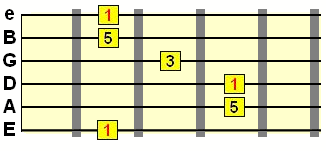
As you can see, this chord form contains only the major triad tones (1, 3, 5) so it gives us a suitable reference point for starting our solo.
All we need to do now is choose a major scale for our solo, also rooted on a D note. Again, use that same low E string root note so you have a clear starting point.
The most commonly used scale patterns rooted on the low E string are the "1st position" boxed patterns, which I show you in all my scale lessons.
For example, we could use the major/Ionian scale:
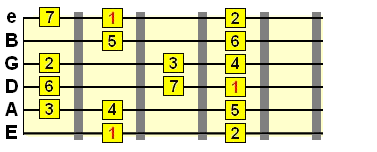
The Lydian scale...
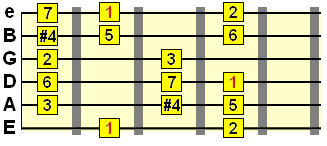
Mixolydian...
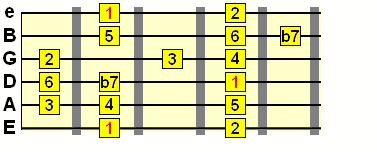
Or something more "exotic" like Phrygian dominant...
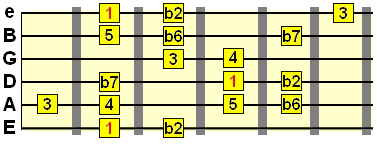
Or even just good old major pentatonic...
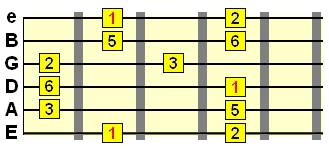
As you can see, all these scales contain the major triad tones (1, 3, 5) and therefore would be compatible with our major chord.
Remember, these corresponding boxed patterns are only used to get our bearings on the fretboard. We don't have to stay around them. If you've learned your chosen scale across the entire fretboard (I have lessons for this in the scales section), then you're free to continue your solo "outside the starting box".
Try out different major scales over this C major backing track (right click and "save as" to download)
So, to summarise...
1. Find the root note of your major chord (D major = D, A major = A, C major = C etc.) on the low E string.
2. Use that same root note for your chosen major scale. Use a scale pattern rooted on that same low E string root note to help you find your bearings.
As soloing over chords is a fairly advanced concept, we need to take things one step at a time. We'll learn how to use scales in a fluid and musical way in a later lesson (or you can get a head start here).
The minor triad contains the root (1), minor 3rd (b3) and 5th (5). All minor scales contain this basic triad.
Let's say our backing chord is C minor (Cm). That means our root note will be C.
So we first find the C note on the low E string (9th fret) and build our minor scale from that point.
If we look at the two most common minor chord forms, we can see that they contain the minor triad (1, b3, 5).
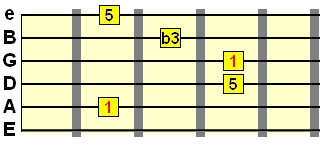
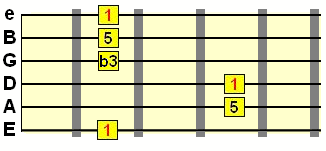
Because all minor scales contain this minor triad, we can choose any minor scale. As we're in the key of C for this example, the minor scale's root note will also be... C! Some minor scales we could play (you can learn these and more in the scales section):
Natural minor...
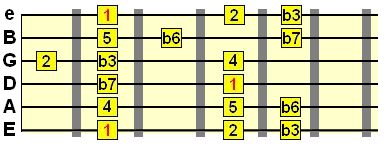
Dorian...
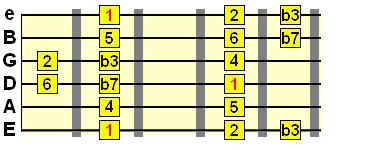
Melodic minor...
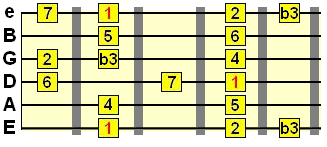
And of course minor pentatonic...
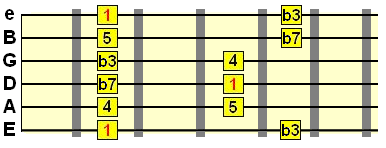
All these scales contain that 1, b3, 5 minor triad. It's the b3 (minor 3rd) that makes them minor scales. As mentioned before, the other tones in these scales are like additional "flavouring" for the basic minor sound, with each scale offering a unique flavour.
So if the backing chord is simply A minor, B minor, C minor etc. or abbreviated as Am, Bm or Cm etc. then you'll know that the chord only contains the minor triad and therefore will be compatible with any minor scale.
Try out some minor scales over this B minor backing track (right click and "save as" to download)
Remember, you can use more than one scale in your solo!
For example, a suspended 4th triad would be: root (1), 4th (4) and 5th (5).
A suspended 2nd triad would be: root (1), 2nd (2) and 5th (5).
What does this tell us about the scales we can use over these chords? As there is no 3rd, we're not limited to major or minor scales.
Basically, just like the major and minor chords, if the scale contains those triad tones, it'll be compatible.
As most major and minor scales contain these tones, we have a wide choice of scales. For example...
Dorian...

Mixolydian...

Harmonic minor...
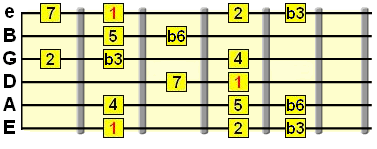
and the major/Ionian scale...

...all contain the 1, 4, 5 or 1, 2, 5 suspended triads. Like with major and minor scales, you could use more than one scale in your solo.
Try out major and minor scales over this A suspended backing track (right click and "save as" to download)
It may not seem obvious now, but repeating this process trains your ear to different scales' tonality, meaning it'll get easier and easier to pick the right scale for the sound you want. It'll also prepare you for learning to solo over chord changes.
If you don't know many scales, don't worry, just spend a little time every day going through my scales section to build up your repetoire. The same goes for chords in my chords section.
Soloing Over 7th Chords
Learn Guitar Scales
Learn Guitar Chords
How to Solo Over Chords - Part 2
In the first part on how to solo over chords, we were introduced to the initial 4 step process for establishing our key and scale.The most basic chord types are known as triads - 3 note chords. These triad types are major, minor, suspended, diminished and augmented.
| Triad Type | Intervals/Tones | Written
as... (when chord root is C) |
| Major | 1 3 5 | C or Cmaj |
| Minor | 1 b3 5 | Cm or Cmin |
| Suspended | 1 4
5 1 2 5 |
Csus4 Csus2 |
| Diminished | 1 b3 b5 | Cdim or C° |
| Augmented | 1 3 #5 | Caug or C+ |
All chords are based on one of these triads, but some may contain additional notes, giving us extended chords.
First, let's focus on triads, as these are the basis of all chord types and will help us narrow down which scales and notes we can use in our solo. There's some overlap between this lesson and the first two parts of the guitar chord theory series, so it's beneficial to spend some time on that series getting to know how chords are constructed.
Video Lesson
Soloing over major chords
Major triads consist of the root (1), 3rd (3) and 5th (5). The 3rd is also known as the major 3rd, and tells us the chord is major. If a chord only contains this basic triad, it's simply called a major chord (e.g. A major, B major, C major) and abbreviated simply with the chord letter (e.g. A, B, C).This means we can use any major scale over that chord, as all major scales contain this triad and you'll see these tones appear in the major scale diagrams on this site. Any additional tones in the scale can be seen as "colouring" the basic major sound. Each scale has its own unique major flavour.
Let's say our backing chord is D major. This means the root note will be D. In the first part, I recommended that you use the bottom 2 strings (I just use the low E string) for your root note, as most chord shapes and scale patterns use a root note on these low strings as the bass note. Therefore, one major chord shape we could build is a standard barre chord rooted on the low E string at the 10th fret (the note D)...

As you can see, this chord form contains only the major triad tones (1, 3, 5) so it gives us a suitable reference point for starting our solo.
All we need to do now is choose a major scale for our solo, also rooted on a D note. Again, use that same low E string root note so you have a clear starting point.
The most commonly used scale patterns rooted on the low E string are the "1st position" boxed patterns, which I show you in all my scale lessons.
For example, we could use the major/Ionian scale:

The Lydian scale...

Mixolydian...

Or something more "exotic" like Phrygian dominant...

Or even just good old major pentatonic...

As you can see, all these scales contain the major triad tones (1, 3, 5) and therefore would be compatible with our major chord.
Remember, these corresponding boxed patterns are only used to get our bearings on the fretboard. We don't have to stay around them. If you've learned your chosen scale across the entire fretboard (I have lessons for this in the scales section), then you're free to continue your solo "outside the starting box".
Try out different major scales over this C major backing track (right click and "save as" to download)
So, to summarise...
1. Find the root note of your major chord (D major = D, A major = A, C major = C etc.) on the low E string.
2. Use that same root note for your chosen major scale. Use a scale pattern rooted on that same low E string root note to help you find your bearings.
As soloing over chords is a fairly advanced concept, we need to take things one step at a time. We'll learn how to use scales in a fluid and musical way in a later lesson (or you can get a head start here).
Soloing over minor chords
Exactly the same process as above, but this time it's the minor triad that will determine which scales we can use.The minor triad contains the root (1), minor 3rd (b3) and 5th (5). All minor scales contain this basic triad.
Let's say our backing chord is C minor (Cm). That means our root note will be C.
So we first find the C note on the low E string (9th fret) and build our minor scale from that point.
If we look at the two most common minor chord forms, we can see that they contain the minor triad (1, b3, 5).


Because all minor scales contain this minor triad, we can choose any minor scale. As we're in the key of C for this example, the minor scale's root note will also be... C! Some minor scales we could play (you can learn these and more in the scales section):
Natural minor...

Dorian...

Melodic minor...

And of course minor pentatonic...

All these scales contain that 1, b3, 5 minor triad. It's the b3 (minor 3rd) that makes them minor scales. As mentioned before, the other tones in these scales are like additional "flavouring" for the basic minor sound, with each scale offering a unique flavour.
So if the backing chord is simply A minor, B minor, C minor etc. or abbreviated as Am, Bm or Cm etc. then you'll know that the chord only contains the minor triad and therefore will be compatible with any minor scale.
Try out some minor scales over this B minor backing track (right click and "save as" to download)
Remember, you can use more than one scale in your solo!
Soloing over suspended chords
Suspended (or "sus") chords in their triad form consist of the root and 5th, just like major and minor triads, but instead of the major 3rd (3) or minor 3rd (b3), intervals of the major 2nd (2) or perfect 4th (4) are used.For example, a suspended 4th triad would be: root (1), 4th (4) and 5th (5).
A suspended 2nd triad would be: root (1), 2nd (2) and 5th (5).
What does this tell us about the scales we can use over these chords? As there is no 3rd, we're not limited to major or minor scales.
Basically, just like the major and minor chords, if the scale contains those triad tones, it'll be compatible.
As most major and minor scales contain these tones, we have a wide choice of scales. For example...
Dorian...

Mixolydian...

Harmonic minor...

and the major/Ionian scale...

...all contain the 1, 4, 5 or 1, 2, 5 suspended triads. Like with major and minor scales, you could use more than one scale in your solo.
Try out major and minor scales over this A suspended backing track (right click and "save as" to download)
Repeat, repeat, repeat!
Pick a chord, major, minor or suspended, find its bass root note and then a compatible scale pattern on that same root note. Ideally, you should record a backing chord (or use the backing tracks in this lesson) and experiment with the various compatible scales over that chord.It may not seem obvious now, but repeating this process trains your ear to different scales' tonality, meaning it'll get easier and easier to pick the right scale for the sound you want. It'll also prepare you for learning to solo over chord changes.
If you don't know many scales, don't worry, just spend a little time every day going through my scales section to build up your repetoire. The same goes for chords in my chords section.
| |
Tweet |
Stay updated and learn more
Sign up to the newsletter for updates and grab your free Uncommon Chords book
Sign up to the newsletter for updates and grab your free Uncommon Chords book
Related
Soloing Over 7th Chords
Learn Guitar Scales
Learn Guitar Chords








